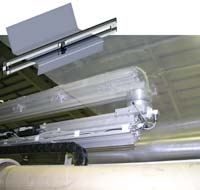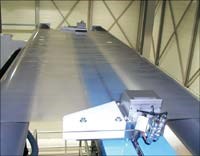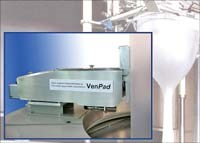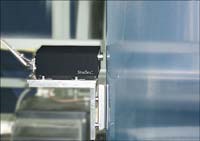Capacitance Thickness Gauges: New Designs Break Old Barriers
Economical, non-nuclear capacitance gauges are opening new markets in blown film—primarily in barrier films, where they previously suffered serious shortcomings. New gauge designs, and new ways of mounting them, make capacitance technology much more flexible.
Capacitance gauges are attempting to solve their historic limitations in blown film thickness measuring, in particular their inability to measure barrier films. Virtually all makers of capacitance gauges brought new models targeting barrier film to the K 2004 show in Dusseldorf last fall.
On display there were new heads, unusual configurations of mounting frames, and new gauging locations below the nip. There were also demonstrations and videos of capacitive gauges controlling barrier film extrusion. The latest news since the show is a new concept that could provide the first capacitance gauge for cast film.
Pluses and minuses
Capacitance gauges create an electric field that passes at an angle through the film, and they mathematically interpret the field strength as a measure of the film's relative thickness. Because air also has capacitance, the position of the film relative to the gauge can affect the readings. Thus any film movement could throw the signal off. To counteract this, the gauges are traditionally in direct contact with the film bubble. They are typically mounted on an oscillating ring just above the frost line, where they can provide feedback for thickness control.
Capacitance gauges have been used for years to control thickness of "plain vanilla" polyethylene films, but they have several disadvantages with other film types. The contacting head doesn't work well with sticky materials like stretch films, metallocene-based resins, or EVA, which can be marred or scratched by the head.
Gauge accuracy depends on the material and temperature. The dielectric signal is easily confused by barrier materials such as EVOH and nylon. The dielectric constants of EVOH and nylon change with temperature and vary drastically at over 150 F. When barrier film is hotter than 150 F, the gauge reads only the barrier layer, recording about 7% of total film thickness. Capacitance readings are also thrown off by moisture and filler levels, and the gauges have to be recalibrated every time there's a change in film thickness.
Add all that up, and most OEMs install capacitance gauges only on monolayer or non-barrier coex blown film lines for PE. For most other films, processors use nuclear thickness gauges, either beta or gamma backscatter.
"In terms of practicality, gamma backscatter is much easier than capacitance for everything," notes the president of one large blown film equipment maker. "It's easy to use and not affected by heat, the type of resin, or the additive loading in the resin. You don't have to recalibrate all the time, and it requires much less maintenance."
Capacitance gauges, however, have two big advantages over nuclear gauges. They're non-nuclear, which is a plus in places like Europe, where nuclear devices are heavily regulated. And they're less expensive. Depending on the size and kind of blown film line, a nuclear gauge installation can be 30% to 100% more expensive than a capacitance gauge, hardware vendors say, and processors often want more affordable gauge control.
Many new choices
K 2004 was the first show at which visitors could see a capacitance gauge actually controlling a barrier film line. Most of the new capacitance gauges at the K show were prototypes. Some had seen a few months of customer trials, while others were built only weeks before the show. Even now, six months later, extruder builders haven't seen the new gauges, much less evaluated them.
An early alternative to non-contact heads were "non-scratching" types that rolled over the bubble on a wheel. These were offered by both Kundig and Plast-Control, mostly for EVA and metallocene PE films. Now there are several truly non-contacting heads on the market.
Kundig displayed its first non-contacting sensor in 1998. It rode on an air stream over the bubble. But it required five more years of development before being commercialized as the KNC-200 sensor 18 months ago.
There isn't much difference between the various non-contacting capacitive heads, manufacturers say. "The difference is in how to keep the distance from the film," says Albert Keller, president of Kundig. "The way you keep your distance has to be accurate and constant."
In late 2003, Kundig launched a two-sided gauge, the S-100 Twin, in a C-shaped frame. It is used on the layflat below the oscillating hauloff, a far less expensive installation than an oscillating ring on a bubble. The gauge was shown at K 2004 controlling thickness on a five-layer barrier film line at the booth of Luigi Bandera SpA of Italy. Kundig now has five commercial installations of the S-100 Twin, all controlling thickness of barrier film—four of them with adjustable air rings and one using an automatic die.
The dual head is designed with the transmitter on top and the receiver on the bottom, whereas heads mounted on the bubble have the emitter and receiver in the same instrument. Kundig's S-100 Twin uses no air cushion. Instead, the film passes through a 1-mm gap between the heads.
Kundig says the signal is more accurate with the Twin because passing a signal through two layers of film in the layflat gives a more consistent thickness reading than bouncing a signal at an angle with a one-sided capacitance head.
The Twin uses two C-frames mounted on either side of the web to read thickness at two places on the layflat. This gives a reading of the film's thickness profile much faster than waiting for a complete rotation of the hauloff. The same sensors also check layflat width, which saves the cost of a separate detector. It is possible to measure thickness with only one C-frame, but that would take two or three times longer, depending on film width, to measure a full circumference.
Kundig's K-100 Twin was also shown at K 2004 in a newer hybrid version combined with a contactless optical sensor from Isis Optronics GmbH. Isis' gauge measures the thickness of up to 16 individual layers in a multi-layer film using white-light interferometry. It takes up to 4000 measurements a second. The advantage of combining two sensor types is that Isis' instrument alone is limited to transparent film. The hybrid gauge was a prototype that has not yet been field tested. It would cost around $100,000.
Plast-Control, SolveTech, and TSM Control Systems also offer doub-le-sided C-frame gauges. Plast-Control says it has 50 installations. At K 2004, Plast-Control showed the prototype of an unusually shaped non-contacting capacitive head, mounted in an elongated C-shaped frame. A two-sided gauge mounts at one end of the frame, which is 2.7 meters wide and has an active scanning area 2.2 meters wide. Instead of being fixed on the bubble, the entire frame slides in and out over the film layflat. So it takes up a lot of room when it pulls back, but it's mounted high in the film tower where it isn't likely to bump into an operator.
This novel device was tested for four months before the show but was not commercially available until last month. At the show, a live video connection showed the gauge running on barrier film at two unidentified customers. Plast-Control says several instruments are now being used to control thickness on five- and seven-layer barrier films.
Because the C-Scanner takes so much space to move in and out over the layflat, Plast-Control is also developing a fixed O-frame scanner with a moving head. The first one was built in April, and Plast-Control has orders for several more. The head scans across the layflat in about 20 sec, avoiding the waiting time for the rotation of the oscillating haul off. After the head has scanned two to six times, it will calculate the thickness profile. Plast-Control says the reading time of 2 min or less should allow the gauge to achieve response times for thickness control that are as short as with an oscillating ring. Both the C-frame and O-frame heads ride on compressed air in a small gap of 0.2 mm.
The main application for the O-frame is barrier film, but it could also be used to control very large blown film lines such as for agricultural film. The O-frame could also be the first capacitance gauge for cast film, Plast-Control says. At present, the sensor is only for films thicker than 12 microns.
A fixed capacitance gauge beyond the nip, either in the collapsing frame or on the layflat, requires a blown film line with an oscillating hauloff. However, it also saves the roughly $30,000 cost of an oscillating ring on the bubble. Installation of a fixed capacitance gauge costs little more than the head (roughly $12,000 to $15,000). Another advantage in operating below the nip is that the film is cool enough that a capacitance gauge can get a reliable signal from barrier film.
However, two gauge makers at K 2004 showed new gauges designed for mounting on the bubble. Octagon Process Technology GmbH in Germany showed the prototype of a non-contact capacitance gauge that rides on a venturi-induced air cushion. Called VenPad, the gauge blows air sideways on the bubble, then follows the suction of the air flow, riding on a constant air gap of less than 1 mm. It measures film as thick as 6 microns with resolution of ±0.1 micron. The prototype gauge was tested three weeks before the K Show at Kuhne GmbH in Germany (parent of American Kuhne). Further tests at Kuhne and one customer reportedly were successful with 22-micron stretch film having an mLLDPE surface layer.
Micro-Epsilon Messtechnik GmbH in Germany showed its patented non-contact capacitance thickness gauge, which is available for the first time on the open market. Until last year, it was available only through Windmoeller & Hoelscher, for which it was developed in 1998. The Filmcontrol 8101 non-contact capacitance gauge rides on a constant air-cushion and measures with resolution of ±0.25 microns, nearly as accurate as contact-type gauges, Micro-Epsilon says. About 25 of these gauges are now installed commercially.
Micro-Epsilon's EC5 combines a capacitive sensor with an eddy-current sensor in a single housing. It measures thickness of monolayer film between a non-contact gauge and a ground roller. The capacitive gauge measures film thickness and the eddy-current measures the distance from the gauge to the roller to compensate for changes in sensor distance from the film.
Control with capacitance
One big question is whether capacitance gauges mounted beyond the nip can control thickness as well as can a gauge on the bubble just above the frost line. Updating time is a lot longer for a gauge beyond the nip. A single fixed head below an oscillating hauloff might need one and a half rotations for the first profile—on a wide bubble, that could take 20 to 40 min. New gauges are intended to shorten that update time before the control software can update settings at the die or air ring. Some systems require three or four full rotations before they can start controlling thickness. Adding an extra capacitance head cuts that update time in half by reading in two locations—but it adds cost.
Gussets are also an issue. C-frame gauges can't be used for a tube of blown film making gusseted bags, since the gusset would have to pass a signal through four layers of film, not two.
SolveTech sees recent competitors' moves into dual-sided heads after the nip as a vindication of its pioneering approach. For 10 years SolveTech has led that market with an inexpensive, dual-sided capacitance gauge (Model BF200) in a low-cost C-frame for mounting on the layflat. It claims hundreds of installations monitoring PE film. In addition, SolveTech has offered dual-head, dual-sided C-frame systems (Model BF 202) for three years.
Until recently, SolveTech's C-frame gauge was used only to monitor, not control, film thickness, but that is changing. In the past year one of its customers, which has used its equipment for five years on barrier film, just recently made software adjustments and to use it for closed-loop thickness control.
Addex has used bubble-mounted contacting capacitance gauges to control thickness in six barrier blown film systems over the past five years. What's unusual is that the capacitance gauge and controls (built in-house from standard components) ride on a carousel around the bubble—the only system known to do so. Addex says that its Redi die controls layer thickness so accurately "that deviations caused by the barrier layer on the overall gauge reading are insignificant."
Related Content
Avoid Four Common Traps In Granulation
Today, more than ever, granulation is an important step in the total production process. Our expert explains a few of the many common traps to avoid when thinking about granulators
Read MoreUnderstanding the ‘Science’ of Color
And as with all sciences, there are fundamentals that must be considered to do color right. Here’s a helpful start.
Read MoreFormulating LLDPE/LDPE Blends For Abuse–Resistant Blown Film
A new study shows how the type and amount of LDPE in blends with LLDPE affect the processing and strength/toughness properties of blown film. Data are shown for both LDPE-rich and LLDPE-rich blends.
Read MoreCooling the Feed Throat and Screw: How Much Water Do You Need?
It’s one of the biggest quandaries in extrusion, as there is little or nothing published to give operators some guidance. So let’s try to shed some light on this trial-and-error process.
Read MoreRead Next
Processor Turns to AI to Help Keep Machines Humming
At captive processor McConkey, a new generation of artificial intelligence models, highlighted by ChatGPT, is helping it wade through the shortage of skilled labor and keep its production lines churning out good parts.
Read MoreLead the Conversation, Change the Conversation
Coverage of single-use plastics can be both misleading and demoralizing. Here are 10 tips for changing the perception of the plastics industry at your company and in your community.
Read More















.png;maxWidth=300;quality=90)















